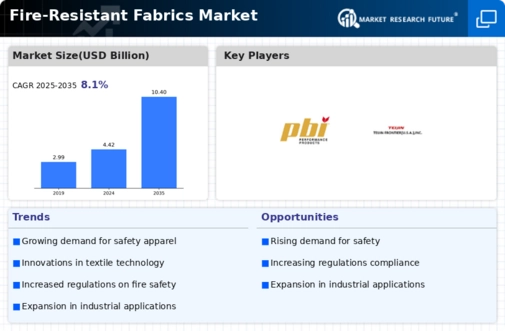Top Industry Leaders in the Fire Resistant Fabrics Market

Fire Resistant Fabrics Market
The fire-resistant fabrics market is a hotbed of innovation and competition. These flame-taming textiles shield lives and property from fiery infernos, playing a crucial role in diverse industries like fire protection, military, industrial, and even fashion. Navigating this dynamic landscape requires understanding the key players, their fire-fighting strategies, and the factors that determine market share.
Leading Firefighters and their Strategies:
-
DuPont: This American giant wields a formidable arsenal of fire-resistant fabrics like Nomex® and Kevlar®, offering exceptional protection for firefighters, soldiers, and industrial workers. Their focus on research and development, like bio-based fire-resistant materials, keeps them ahead of the curve. -
Honeywell International: Another American powerhouse, Honeywell boasts its Flame Retardant (FR) Solutions portfolio, catering to various applications like aircraft interiors and electrical insulation. Their focus on global expansion and strategic partnerships fuels their growth. -
Torrecid Group: This Spanish multinational excels in manufacturing specialty fibers like meta-aramid, used in high-performance fire-resistant fabrics. Their focus on vertical integration and raw material sourcing strengthens their position in the supply chain. -
Basofil Fibers: This Belgian company specializes in developing FR viscose fibers, offering a cost-effective and sustainable alternative to traditional synthetic options. Their focus on eco-friendly solutions and niche applications like protective clothing for firefighters resonates with environmentally conscious customers. -
Teijin Ltd.: This Japanese leader excels in producing high-performance PBO fibers, known for their exceptional strength and heat resistance. Their focus on technological innovation and advanced applications like aerospace fabrics keeps them at the forefront.
Factors that Fuel Market Share:
-
Fabric Performance and Functionality: Offering fabrics with superior flame resistance, heat insulation, and comfort is crucial for attracting customers across diverse applications. -
Durability and Cost-Effectiveness: Providing fabrics that withstand wear and tear while remaining cost-competitive is essential in the demanding fire-resistant market. -
Regulatory Compliance and Certifications: Meeting stringent fire safety regulations and obtaining relevant certifications is critical for market access and customer trust. -
Sustainability and Environmental Impact: Minimizing the environmental footprint of fire-resistant fabrics through eco-friendly materials and production processes is gaining traction. -
Innovation and New Applications: Developing novel fire-resistant fabrics with unique properties like self-healing or water repellency opens up new market opportunities.
Key Companies in the Fire Resistant Fabrics market include
- I. DuPont De Nemours and Company (U.S.)
- Kaneka Corporation (Japan)
- PBI Performance Products Inc. (U.S.)
- Royal TenCate N.V. (Netherlands)
- Teijin Ltd. (Japan)
- Westex By Milliken (U.S.)
- Gun EI Chemical Industry Co., Ltd. (Japan)
- Huntsman Corporation (U.S.)
- Lenzing Ag (Austria)
- Solvay S.A. (Belgium)
- L. Gore Associates Inc. (U.S.)
Recent Developments:
-
September 2023: DuPont launches a new line of breathable and lightweight FR fabrics for firefighters, enhancing comfort and mobility during operations. -
October 2023: Honeywell International develops a new FR fabric with enhanced electrical conductivity, targeting applications in electrical insulation and protective gear. -
November 2023: Torrecid Group unveils a new line of flame-retardant fabrics for outdoor apparel, catering to the growing demand for fire safety in recreational activities. -
December 2023: A consortium of universities and research institutions receives funding to develop a novel type of fire-resistant fabric that can change color when exposed to heat, providing early warning of potential fire hazards.

